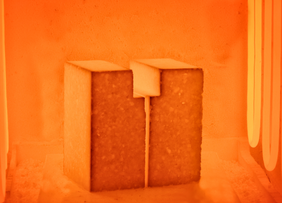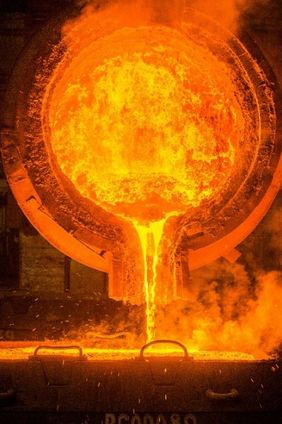The Materials Center Leoben and the Chair of Ceramics at the Montanuniversität Leoben concentrate on the properties and application behavior of high-temperature ceramics in a joint research focus. The aim is to develop suitable methods for testing material properties up to over 1300°C and to improve the understanding of the deformation and fracture behavior of coarse ceramic products.
Creep processes play an important role in many materials when they are mechanically stressed at high temperatures. Creep starts at approx. 20 - 30 % of the melting temperature of a material. Creep is the slow deformation of the material over a longer period of time at a constant load. A simple example of creep deformations in everyday life can be observed with bookshelves, which deflect over time and sometimes break.
Creep deformation plays an important role especially in high-temperature processes. In project P4.5, high temperature creep and fracture behavior of refractory materials at temperatures up to and above 1300 °C were investigated.
Industrial furnaces and transport vessels for metallurgical applications often have dimensions of several meters and are lined inside with refractory materials that withstand extreme temperatures, chemical attack and mechanical loads. The computer-aided calculation of the occurring stresses is indispensable for the design of such high-performance components. In order to perform calculations as accurately as possible, material data is required for creep and fracture behavior at high temperatures. In addition, digital material models are required to calculate the behavior of the refractory materials and the components made from them.
In close cooperation with industry, new experimental test methods were developed to measure the creep behavior of refractory materials under uniaxial and multi-axial loads. With the knowledge gained from these tests, new creep models were created which make it possible to calculate the stresses occurring in the components with considerably higher accuracy than before. Furthermore, wedge-slit tests were performed for fracture mechanical characterization. A wedge-slit specimen used for this purpose is shown at 1300 °C on the title page. Material data from these tests were evaluated and implemented in the computer simulation models.
Impact and Effects
In project P4.5, pioneering insights were gained on the testing and simulation of the material behavior of high-temperature building materials. Today, the newly available material data together with improved computer models are already used by the industry partners of the project to improve the design of linings, such as those shown in the following Figure, that are used in metallurgical plants at high-temperatures. Furthermore, the new test methods and the newly gained material data also provide a sound basis to advance material development. Both, new materials and the availability of new computational design tools will strengthen the international competitiveness of the company partners.
The findings of this project were published in eight scientific publications and presented at four international conferences.
Project coordination (Story)
Priv.-Doz. DDr. Shengli Jin
Priv.-Doz. DI. Dr. Dietmar Gruber
Montanuniversität Leoben, Chair of Ceramics
Peter Tunner Straße 5, A-8700 Leoben, Austria
T +43 (0) 3842 402 3236
shengli.jin(at)unileoben.ac.at
Project partner
RHI Magnesita AG, Austria
voestalpine Stahl GmbH, Austria




















